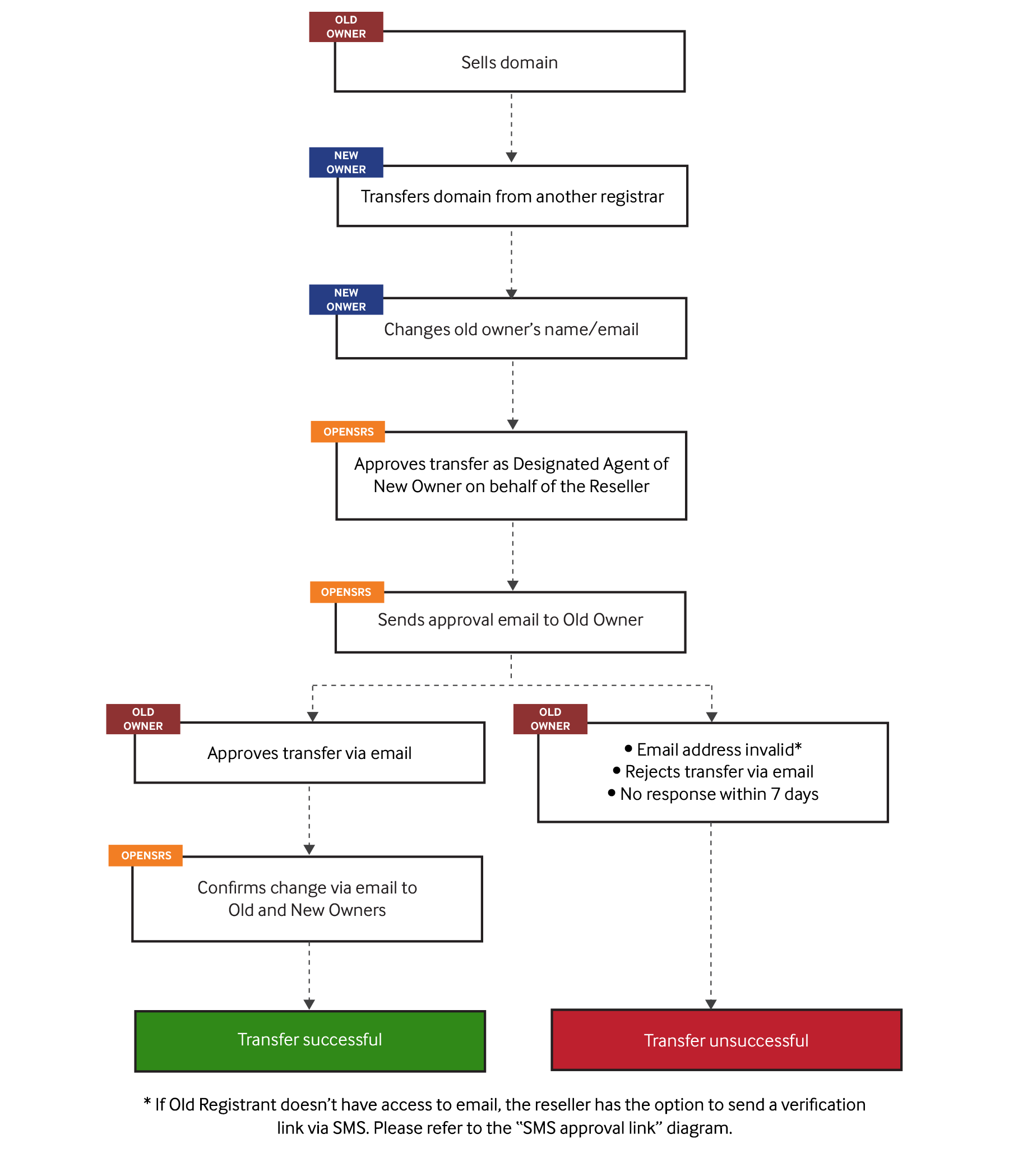On December 1, 2016, ICANN enforced a new Transfer Policy that modified the process of changing domain ownership from one registrant to another. Under this policy, any update to a domain’s registrant contact data must be approved by both the current and new registrant via email. Once both parties have approved the change, each receives a confirmation email that the change of registrant is complete. We call this process “Change of Registrant” or COR, for short.
What’s important to note is that the current and new registrant are often the same registrant: a simple update to a registrant’s first name, last name, organization or email address on a particular domain also triggers the same slew of notification and confirmation emails.
In May 2018, OpenSRS temporarily suspended our COR process because of some concerns around data privacy and GDPR compliance. However, we are required by ICANN to enforce the COR process and have been working with them to revise our COR process to satisfy both ICANN requirements and OpenSRS’ data privacy commitments.
On March 31, 2020, OpenSRS will re-enable our COR process. It will be very similar to the COR process we introduced in 2016, with a few important changes.
Below you’ll find a detailed explanation of the COR process, how it’s changed, and what you need to do to prepare.
Designated Agent: minimizing the impact of COR
How will it impact your business?
How is the new COR process different?
How does the new process work?
Preparing for the updated COR process
FAQ for resellers
End-user frequently asked questions
Designated Agent: minimizing the impact of COR
The request-for-approval emails that are sent to both the current and new registrant have proven to be quite a nuisance, for both end-users and reseller support teams. Thankfully, there is a workaround: the registrant can have OpenSRS, or more accurately, Tucows, act as their “Designated Agent” (DA) with the ability to auto-approve any requested changes to the registrant’s contact set. Registrants that have DA enabled do not receive COR request-for-approval emails.
As a reseller, you have the option to pre-enable the Designated Agent option for all registrants of all future and existing gTLD domains you have with us as a registrar.
How will it COR impact your business?
When OpenSRS re-enables COR on March 31, the impact on resellers and their end-users will be visible:
- Any changes to the first name, last name, organization or email address fields for the owner of any gTLD domain name will trigger the COR process
- OpenSRS will send a request-for-approval email obtaining explicit confirmation from the current and new registrants before a change can be completed. Note: we do not send a request-for-approval email to a registrant for whom Tucows is set as the DA. Learn more
- After a change of registrant has been completed, the previous and new registrant will receive a confirmation notice informing them that the change has completed
- After a change of registrant has been completed, the domain is by default locked for transfers to a new registrar for the following 60 days. If DA is enabled, the end-user doesn’t get the opportunity to opt to turn off the 60-day lock (via the request-approval-email). Instead, the reseller would have to opt out of the 60-day lock for the end-user via the API using the “modify_trade_lock_setting” command. More details below.
How is the new COR process different?
Our updated COR process is very similar to the one we implemented in 2016. However, there are a few important changes that you’ll need to note:
1) You can apply Designated Agent to all future and existing domains
When we first implemented COR, we provided resellers with a one-time-use tool that set Tucows as the Designated Agent (DA) for all existing registrants in their reseller account. We will once again provide you with this option, but it will now set Tucows as the DA for all future registrants in your account as well as existing.
Learn how to enable DA at an account level.
2) COR will not apply to privacy-protect domains
Moving forward, if contact changes are made to a domain that’s protected with Whois Contact Privacy, the COR process will not be triggered. The change of registrant would be processed without any approval emails being sent. This may seem odd, but it’s an ICANN-mandated change.
3) We’ve Updated the COR Email Templates
Changes have been made to the content of the end-user COR email templates. You can find the new templates (available in all our standard languages) in the Messaging section of the Reseller Control Panel:
• Change of Registrant Confirmation for New Registrant
• Change of Registrant Confirmation for Current Registrant
• Notification for Completed Change of Registrant
The old templates—marked “deprecated”—will remain available for you to use as a reference when making customizations. The deprecated templates will remain available until April 30, 2020.
How does the new process work?
The process starts with the reseller submitting a request to modify the owner of a given domain name.
OpenSRS will then check if the New Registrant has previously accepted Tucows to act as a Designated Agent (DA) or if the reseller has done so on the registrant’s behalf. If so, OpenSRS would auto-approve the change for the New Registrant. Otherwise, OpenSRS will send an email to the New Registrant. This email will direct them to a landing page where the end-user will be asked:
- to approve or decline the Change of Registrant,
- to confirm that their information is correct (as per Registrant Verification), and
- accept Tucows to act as a Designated Agent for all future changes of registrant (optional)
Once the change has been approved by the New Registrant, OpenSRS will check if the Prior Registrant has accepted Tucows to act as a DA or if the reseller has done so on the registrant’s behalf. If that is the case, OpenSRS would auto-approve the change for the Prior Registrant. Otherwise, OpenSRS will send an email to the Prior Registrant, asking them:
- to approve or decline the Change of Registrant, and
- opt out of the 60-day registrar transfer lock after a Change of Registrant (optional).
After both approvals have been recorded, OpenSRS will complete the Change of Registrant and send a final confirmation to both Prior and New Registrant which notifies them about the completed process. In this scenario, the New Registrant will not receive a subsequent email to complete the Registrant Verification process, as this has already been completed with the initial confirmation. Even if the email address of Prior and New Registrant is the same, the policy requires OpenSRS to send two separate emails.
In case the New or Prior Registrant decline a change, or the request times out after 7 days, the entire process is aborted, and the present owner details will stay in place.
To help you better understand how this works, we have simplified the new process into five likely scenarios that may apply to all resellers. Please note: our systems will accommodate all scenarios.
Scenario A
- New Registrant uses Tucows as Designated Agent
- Old Registrant uses Tucows as Designated Agent
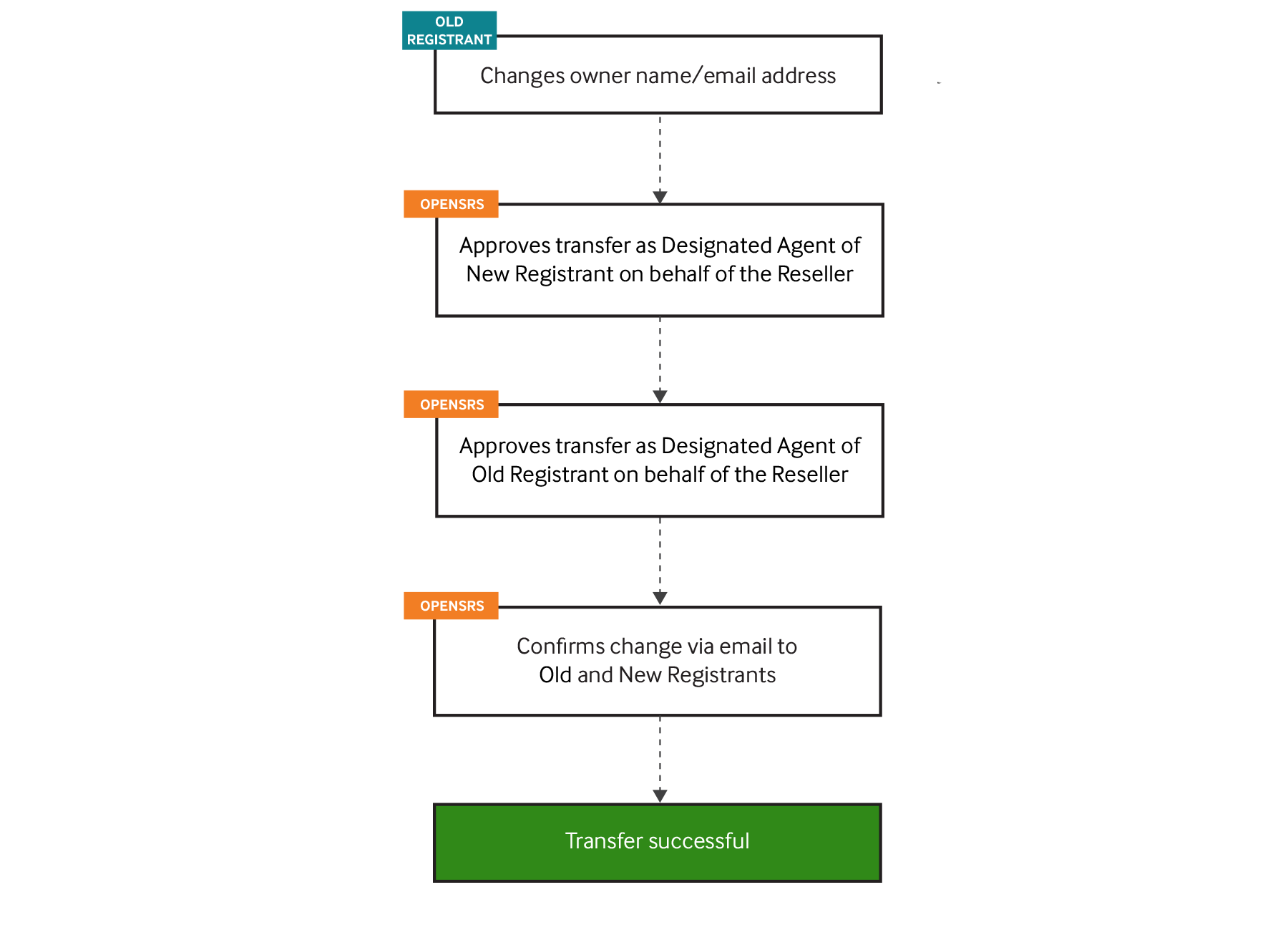
Scenario B
- New Registrant doesn’t use Tucows as Designated Agent
- Old Registrant uses Tucows as Designated Agent
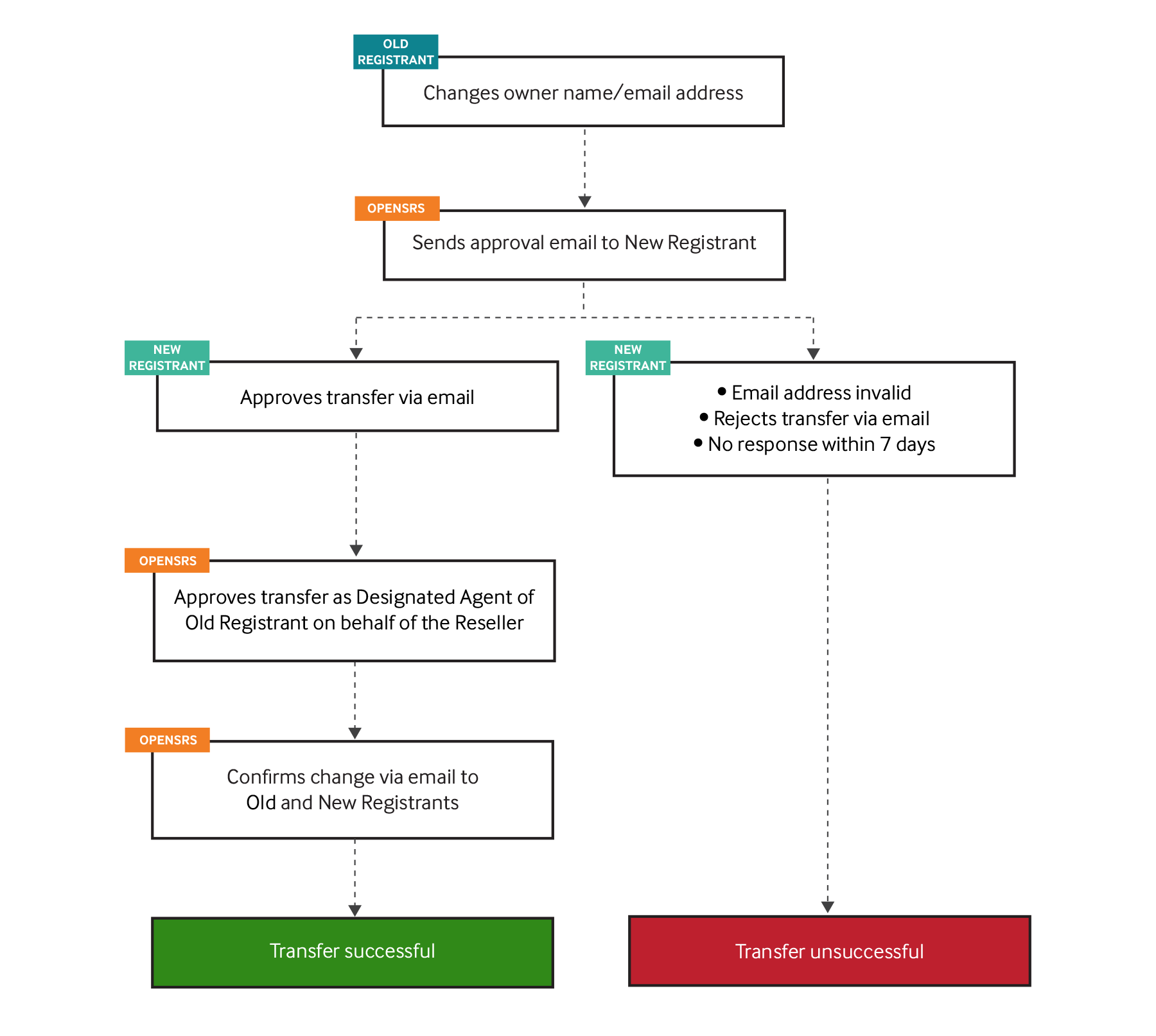
Scenario C
- New Registrant uses Tucows as Designated Agent
- Old Registrant doesn’t use Tucows as Designated Agent
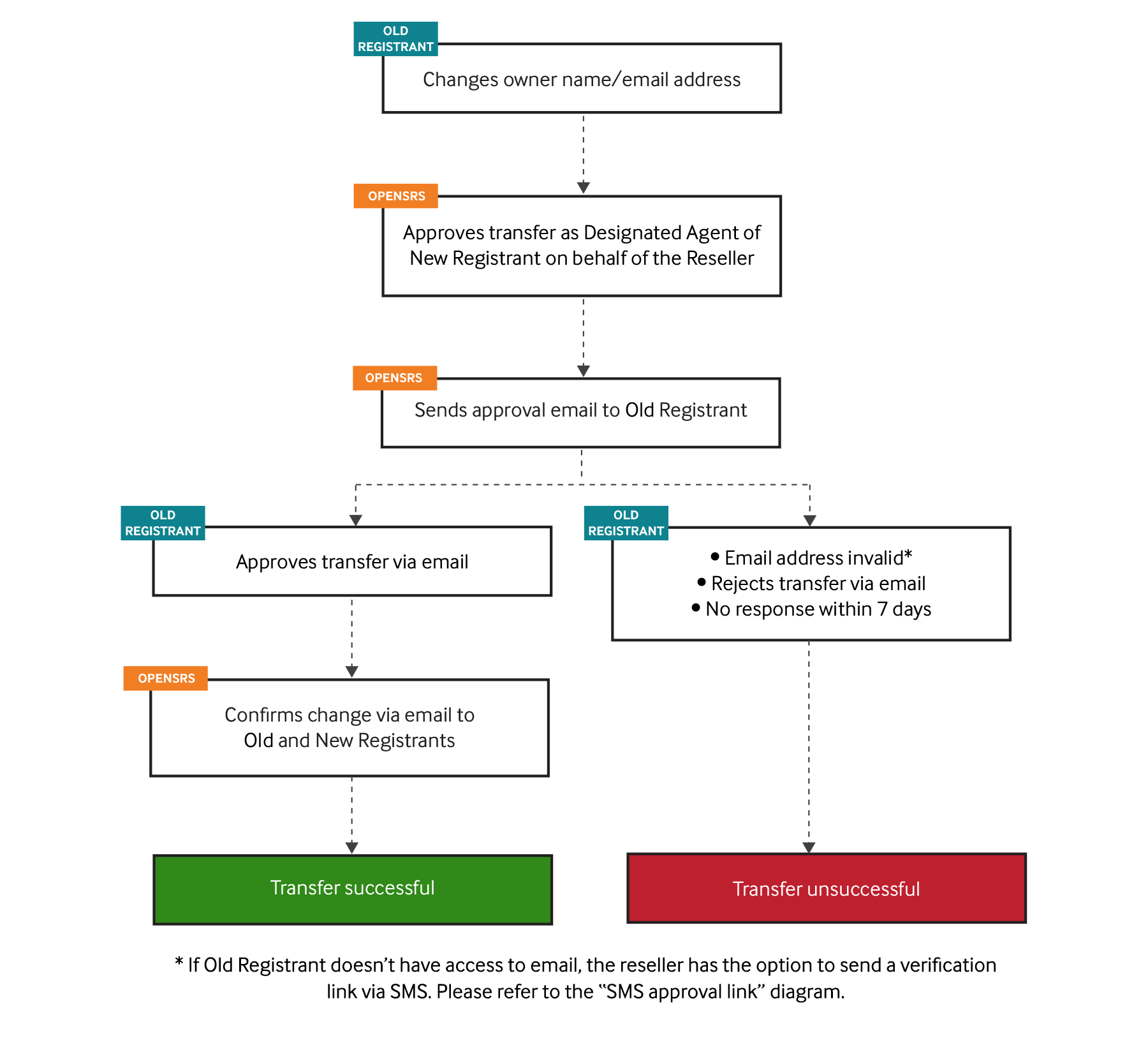
Scenario D
- New Registrant doesn’t use Tucows as Designated Agent
- Old Registrant doesn’t use Tucows as Designated Agent
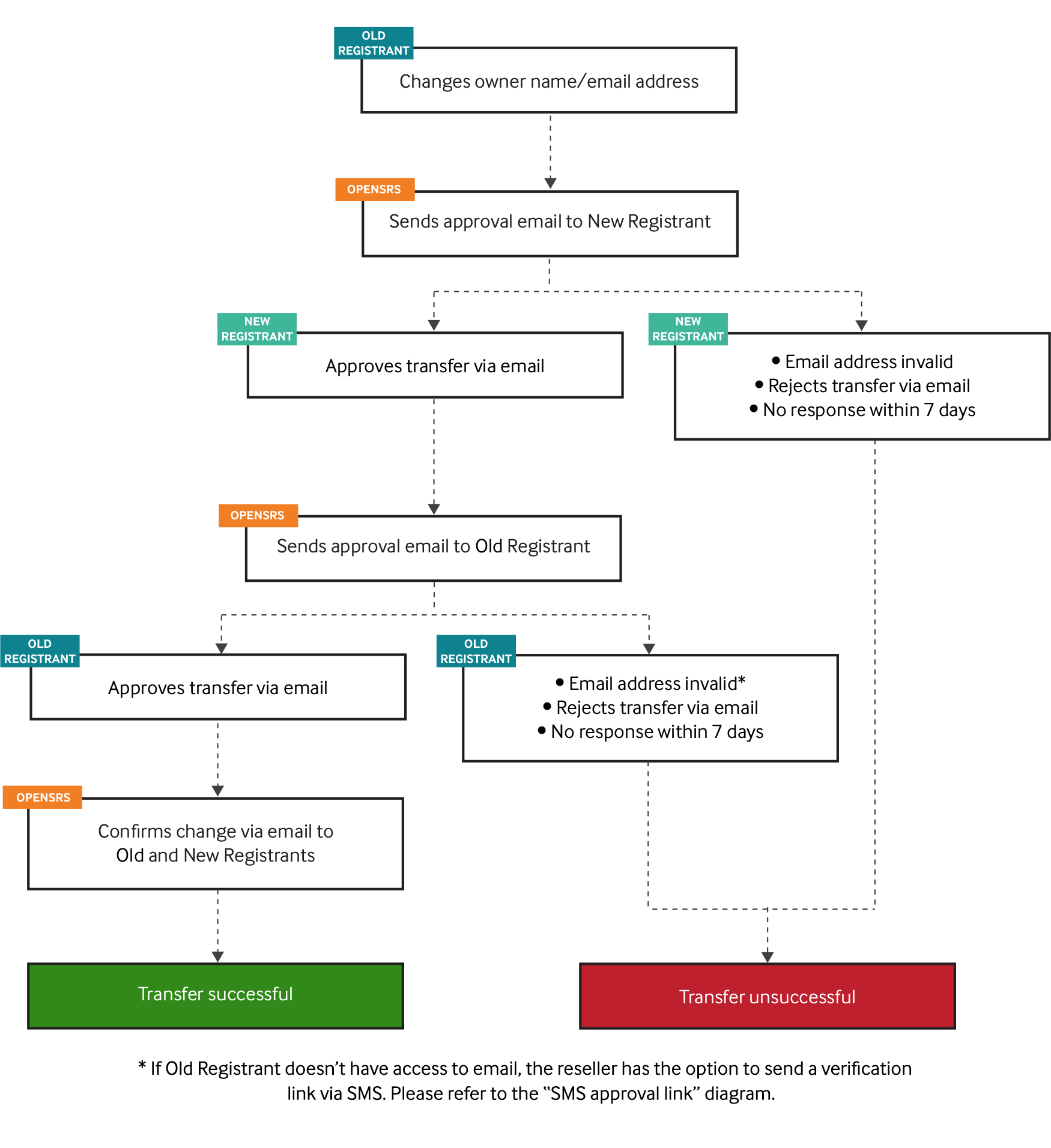
Master Chart
- New Registrant uses Tucows as Designated Agent
- Old Registrant uses Tucows as Designated Agent
Preparing for the updated COR process
Completing the tasks below will minimize the impact COR will have on your business and ensure you are ready for its re-enablement on March 31, 2020.
1) Enable Designated Agent for all existing and future domains in your account.
If you previously opted to enable DA for all domains in your account and wish for DA to remain enabled for all domains by default, you will need to log into the Reseller Control Panel and re-enable it manually. If you do not, DA will be disabled by default for all domains added to your account since May 2018, when COR was temporarily disabled.
The option to enable DA for all domains is available in our testing environment. Please note you cannot send out emails from the testing environment.
If you have not previously enabled DA by default for all domains in your account, we highly recommend you do. Doing so reduces end-user confusion and your support efforts. Follow our step-by-step guide.
This option to enable DA for all future and existing domains is available in the Reseller Control Panel (view details). Before enabling DA on an account-wide level , you’ll be asked to confirm that you meet all the legal requirements. Specifically, we will ask you to confirm the following:
- You have incorporated the Tucows Registration Agreement in its latest version into the contract with your customer/domain registrant. The latest version includes a provision for the registrant to accept Tucows as Designated Agent.
- You are requesting a domain registration or transfer at OpenSRS only after the registrant has entered into such agreement.
- You can present proof, upon future request, that a registrant of a specific domain has accepted a contract that binds them to our Registration Agreement. Proof could be a timestamp log (e.g. 3:00UTC, date: 21/2/13, domain: example.com, registrant: John Doe, registrant IP: 122.111.222), a copy of a written and signed contract, or a screenshot of an Executed Agreement for the domain including domain name, registrant, and date/time of execution). We will ask you for this information if ICANN requests us to present this during an audit.
The option to enable DA for all registrants is also available in our testing environment.
Check out our step-by-step instructions to enable DA for all domains.
2) Make sure you are familiar with our COR-specific API commands
If you use the API, you’ll want to take a look at our COR-specific API commands. They live in the “ICANN Trade” section of our API documentation. The API commands are the same as those introduced in 2016 when COR the process was first implemented. No new commands have been added.
3) Customize your COR end-user email templates
New end-user COR email templates are available in the Messaging section of the Reseller Control Panel:
The three new templates are:
• Change of Registrant Confirmation for New Registrant
• Change of Registrant Confirmation for Current Registrant
• Notification for Completed Change of Registrant
They are available in all of our standard languages.
The old templates—marked “deprecated”—will remain available for you to use as reference when making customizations. They’ll remain available until April 30, 2020.
4) If you haven’t done so already, change the link colours and add a custom URL for your confirmation pages under brand settings within the Reseller Control Panel. If you haven’t uploaded your logo yet, now is a good time to do so.
IMPORTANT: confirmation pages will be shown in the same language as the Change of Registrant emails.
5) If you have any questions, please review our COR Knowledge Base articles:
Overview: Change of registrant (COR) for gTLD domains
How to enable/disable Designated Agent (DA) for COR process
What is the process if both the New and the Prior Registrant have accepted Tucows as a Designated Agent?
In this case, the entire process completes immediately without Registrant approvals required. Both Prior and New Registrant will receive a notification about the completed change. The New Registrant will subsequently receive an email request to complete the Registrant Verification process.
What happens if the current registrant email is invalid or not accessible?
If a confirmation email sent to the New or Prior Registrant bounces, or it is no longer accessible, the reseller will have the opportunity to resend the confirmation request
- to the same email address (if the bounce was just temporary), or
- via SMS to the phone number supplied for the Registrant.
If the phone number is incorrect, the reseller has the option to update the current registrant details with a new, valid mobile phone number. Updating just a registrant’s phone number is not considered a change of registrant by the Transfer Policy, so OpenSRS will process this update without confirmation. Once the phone number is correct, the reseller can then resend the confirmation email to the new, updated phone number.
Please see our step-by-step guide for more information.
SMS approval link scenario
- New Registrant uses Tucows as Designated Agent
- Old Registrant uses Tucows as Designated Agent
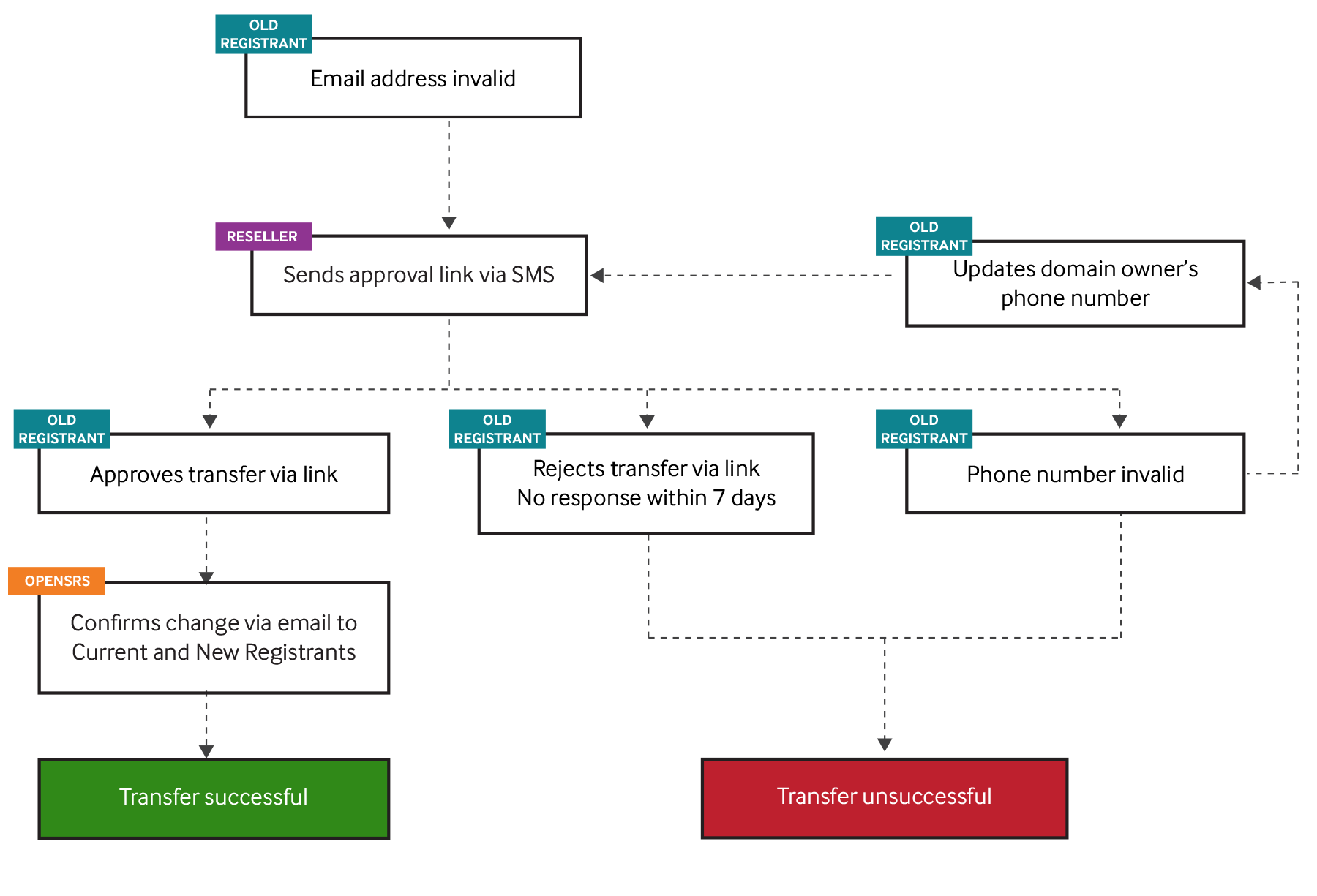
How will I know if my request has timed out or has been denied? How will I know when the change is “approved” by the prior and new registrant contact?
A setting will be available in the Event Notifications Tab (In the Reseller Control Panel) to enable either a poll and/or email message notification. Tucows will also introduce a new, internal status that we’ll make available to Resellers. For customers integrated with our API, you may see the request to check status: “icann_trade_status_change”.
Questions our resellers have been asking
Q: What happens if I don’t re-enable DA at the reseller account level?
.
A: If you do not take action to re-enable DA for all domains in your account, DA will be disabled by default for all registrants (and their domains) that were added to your account since May 2018, when COR was temporarily disabled. This means that these registrants would receive request-for-approval emails if and when a change to their domain contact details is made
If a registrant previously set Tucows as the DA for their account, DA would remain enabled for the registrant once our COR process is re-enabled on March 31, 2020.
Moving forward, you also have the option to enable DA on a per-registrant basis via the API. You can also enable DA while manually completing a change-of-registrant on a domain from within the Reseller Control Panel.
Q: What happens if I choose not to enable DA at the reseller account level?
.
A: If you do not set Tucows as the DA for all existing and future domains in your account, DA will be disabled by default for all registrants (and their domains). Registrants that haven’t enabled DA will receive request-for-approval emails if and when a change to their domain contact details is made
Moving forward, you also have the option to enable DA on a per-registrant basis via the API. You can also enable DA while manually completing a change-of-registrant on a domain from within the Reseller Control Panel.
Q: Where do I find details about the new APIs that OpenSRS is providing for this policy?
A: We have added documentation for the additional API calls to our online API documentation available at domains.opensrs.guide. Please see the “ICANN Trade” section for all new API commands.
Q: Is it correct that once a Registrant accepts Tucows as Designated Agent (DA), the Registrant itself has no way to revert this decision, and only the reseller can disable the DA setting?
A: This is correct. Only the reseller can revert the DA setting on behalf of a Registrant via a specific API. View documentation
Q: Will a Current Registrant be able to accept Tucows as a Designated Agent when confirming a Change of Registrant?
A: A Current Registrant would receive a confirmation email only in a scenario where they haven’t accepted Tucows as their Designated Agent yet, or their reseller hasn’t enabled the DA setting on their behalf. For this scenario, we have decided against giving the Current Registrant the option to accept Tucows as the DA, as generally they will soon no longer be the registrant at all. While theoretically they still could be a registrant for other existing or future names, it would be difficult to understand this scenario to the user exposed to the confirmation page.
Q: Consider the following scenario:
Alice as a New Registrant approves a Change of Registrant and accepts Tucows as a DA. The change completes, and the domain is transfer-locked for 60 days.
5 days later, Alice changes ownership of the domain again to Bob as the New Registrant. Bob as the New Registrant accepts the change.
As Alice has previously accepted Tucows as the DA, OpenSRS will auto-approve the change for Alice as the Current Registrant, without giving Alice the chance to opt-out of the transfer lock.
Is there any way for Alice to still opt-out of the transfer lock? And if there is, will she be able to override the transfer-lock setting from the previous transfer?
.
A: It is correct that in this scenario Alice would not receive a confirmation email which would allow her to opt-out of the transfer lock. However, as a reseller you can give Alice the option to opt-out of the transfer lock in your portal at the time when she changes the registrant to Bob. OpenSRS provides an API to modify the transfer lock setting prior to submitting a Change of Registrant. View documentation
If Alice opts out of the transfer lock, her choice will override the transfer lock that was applied from the previous Change of Registrant, and the domain will not be locked after the change has completed
Q: When a reseller enables DA for all registrants/domains in their account, Tucows will be the Designated Agent and auto-approve Change of Registrant requests for these registrants. Due to the auto-approve, the Current Registrant will not have the option to opt out of the transfer-lock. Does this mean that in this scenario the transfer lock will apply to all domains coming out of a Change of Registrant process?
>
A: Yes, all Current Registrants who have accepted Tucows as DA will not get a confirmation email, so by default the transfer lock will apply to them. Resellers who want to give their customers the option to transfer the domain away to another registrar anytime after a change can do so by implementing the modify_trade_lock_setting API. View documentation
Q: Why do I need to submit a domain name when setting the Designated Agent option for an existing registrant via the modify_trade_lock_setting API? Doesn’t the Registrant accept the Registration Agreement for all domains they own?
A: We ask for the domain name as a simple way to specify which registrant has accepted the Registration Agreement. When you use that API, OpenSRS will look up the owner contact of the given domain and set the “DA accepted” option for the specific firstname, lastname, organization, email combination found in that owner contact. The DA setting will then apply for all existing or future domains that share this unique combination as a Current or New Registrant.
Q: Can I automatically opt-out of the 60-day transfer lock for all of the domains in my reseller account?
A: No, the policy does not allow us to provide such setting on a reseller level. The language of the Transfer Policy specifies that only the Registrant themselves can opt-out of the transfer-lock.
Q: Does this implementation of the new transfer policy also apply to country-code top-level domains (ccTLDs)?
A: No, it only applies to generic top-level domains (gTLDs) which are all governed by ICANN policies. ccTLDs usually have their own policies, and are not affected by these changes.
Q: How does this new COR affect using whois privacy on domains?
A: COR will not apply to privacy-protect domains. Moving forward, if contact changes are made to a domain that’s protected with Whois Contact Privacy, the COR process will not be triggered. The change of registrant would be processed without any approval emails being sent. This may seem odd, but it’s an ICANN-mandated change.
Q: Am I able to customize the confirmation page that new and current registrants will see after they click the emails?
.
A: Yes, branding settings that allow you to customize these confirmation pages are available in the Reseller Control Panel. Confirmation pages will be shown in the same language as the Change of Registrant emails
End-user frequently asked questions
As we have stated before, COR is a complex process. It has the potential to disrupt your current processes, particularly if you do not enable DA for all domains by default. To help your end-customers understand these changes, we have developed questions and answers. This section will constantly be updated to ensure your customers have the most current information.
Q: What would trigger this change of registrant process?
A: Making any change to the first name, last name, organization field, or email within the registrant contact object, will start the process. An approval email will go out to both the old and new registrants.
Q: What happens if it’s not an actual transfer but minor updates to first name, last name, email or organization field?
A: As of March 31, 2020, any change to any of those fields will begin the change of registrant process.
Q: Who has to approve the change of registrant request?
A: Both the new and the prior registrant need to approve the change of registrant request.
Q: What if I am both the old and the new registrant?
A: You will be required to approve the change of registrant request twice.
Q: What happens if the new registrant approves the request but the old registrant denies the request?
A: This will cancel the whole request and the whois will revert back to the previous registrant’s info.
Q: What happens if the new registrant denies the request?
A: Then the change of registrant request is canceled and the previous whois info remains the same.
Q: What happens if I am the new registrant and I do not receive the email request to approve the change of registrant?
A: Your domain provider will be able to resend the email, otherwise the process will timeout. You will need to start the process again using a different email address.
Q: How long does the new registrant have to approve the request before it expires/times out?
A: 7 days from the change request.
Q: What happens if I submit another change of registrant request when one is currently pending?
A: The first request will be cancelled.
Q: What if I don’t have access to my old email address?
A: Your domain provider can explicitly send a link via SMS to the phone number that they have on file. This will allow you to approve the change of registrant request.
Q: What happens if the number on file is not a mobile phone number?
A: Depending on the service we use, we may be able to use features available that can contact registrants at a landline. Otherwise, it is recommended to update the phone number field with a mobile number.
Q: After a Change of Registrant, are there any restrictions on transferring that name?
A: If you want to transfer registrars and change the registrant at the same time, you should transfer the domain first, and then the change the registrant. Failure to do so will result in your domain being locked for 60 days.
Q: Is there anyway to opt out of the 60 day lock after a change of registrant is applied?
A: Yes, OpenSRS will offer the prior registrant a chance to opt out of the 60 days transfer lock at the time of the initial Change of Registrant request. This option can be enabled via the End User Control Panel, or through your Domain Provider.

